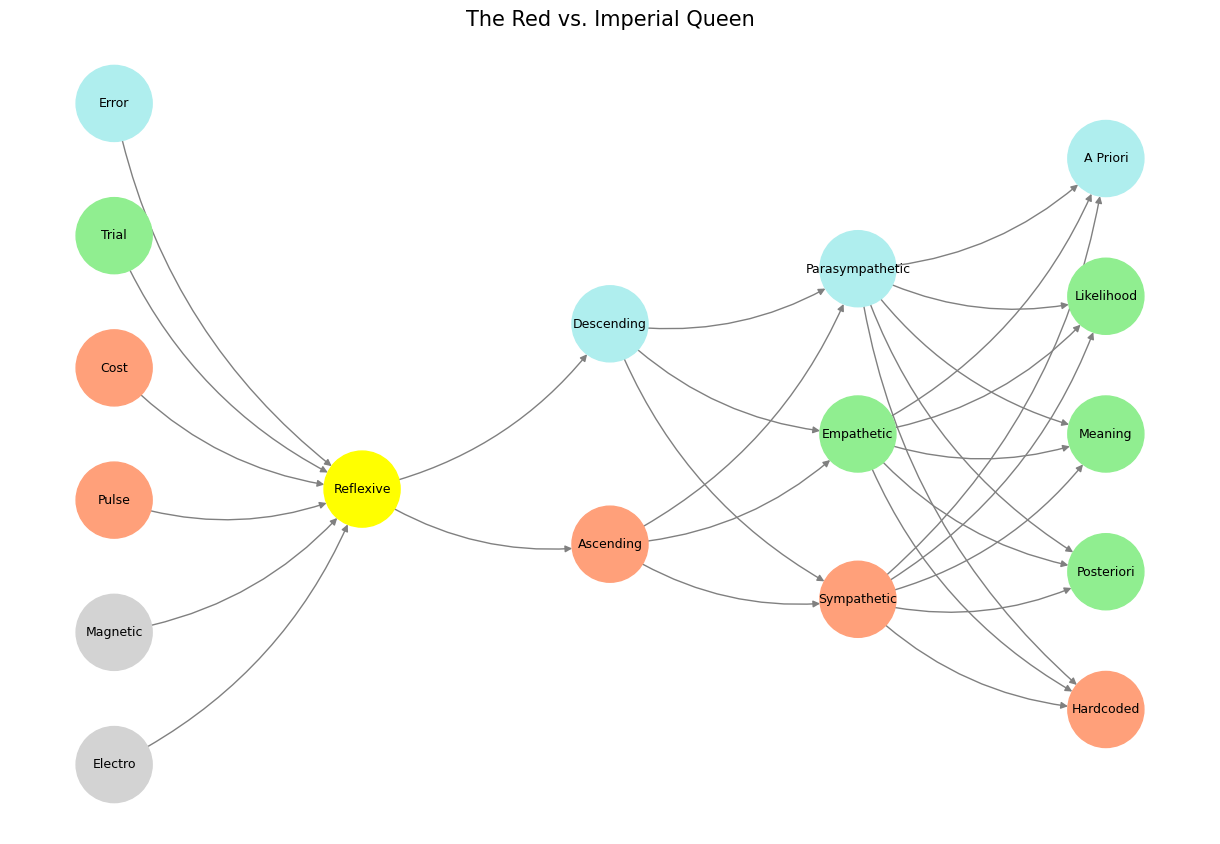Dancing in Chains#
Red Queen vs Queen Victoria#
The Red Queen Hypothesis, a concept from evolutionary biology, describes the relentless competition in nature: species must constantly adapt to survive against ever-evolving rivals, predators, and parasites. This hypothesis embodies the laws of the jungle, where survival is dictated by agility, aggression, and adaptability. It aligns with the sympathetic nervous system, the primal fight-or-flight response that governs immediate survival in the face of threat. The Red Queen’s world is one of perpetual motion, where stillness means extinction, and every adaptation is met with a counter-adaptation. The struggle is not to reach a final state of dominance but to avoid obsolescence in an ecosystem that never stops shifting.
Queen Victoria, by contrast, represents the opposite impulse: the imposition of moral order onto a chaotic world. Victorian morality sought to tame the raw instincts of humanity through discipline, propriety, and an elaborate system of social mores. This was not a realm of perpetual adaptation but one of rigid stability, where duty, restraint, and decorum reigned supreme. The Victorian era saw an unprecedented expansion of industrial and colonial power, yet its social framework demanded the repression of individual desires in favor of a collective ideal of civilization. If the Red Queen’s world is a war of constant motion, Queen Victoria’s world is a fortress of static control.

Fig. 28 Inheritence, Heir, Brand, Tribe, Religion. Karoline Leavitt’s voice has a melody, rhythm, timing, and cadence that is comparable to a fledgling pianists first recital. It’s not idiomatic, doesn’t flow, and talking points are repeated in overplus. She’s following a prompt.#
Yet, beneath its surface, Victorian sensibility was not immune to the Red Queen’s relentless pressure. Industrialization created new economic and social forces, leading to upheavals that challenged the rigid moral codes of the era. The Victorian world, for all its insistence on order, had to continuously redefine itself in response to scientific discoveries, political changes, and global competition. Even the moral framework that sought to suppress human instincts had to evolve—hence the contradictions of Victorianism, where prudishness coexisted with vast imperial violence, and repression fostered underground currents of radical thought and art. The Victorian era, though fixated on stability, was never truly at rest.
The clash between these two queens—one red, relentless, and organic; the other imperial, ordered, and artificial—mirrors the deeper tension in human civilization between the instincts that drive survival and the structures that attempt to regulate them. The sympathetic nervous system, which fuels the Red Queen’s race, ensures that organisms stay alive moment to moment. Victorian morality, akin to the prefrontal cortex imposing reason upon impulse, sought to extend this survival into a grand narrative of refinement, legacy, and civilization. Yet, as the Red Queen Hypothesis reminds us, nothing remains static. The Victorian world eventually fractured, giving way to modernity, while the jungle’s brutal laws persist beneath every layer of human artifice.
In the end, Queen Victoria’s world was a temporary illusion, a dam holding back forces far older and more fundamental. The Red Queen never abdicates. She rules through biology, competition, and the inexorable pressures of survival. Victorian sensibilities may have sought to contain her, but they, too, became part of her game—reshaped, eroded, and ultimately outpaced. The real question is not whether the Red Queen or Queen Victoria prevails, but how long any structure of control can hold before it is forced to evolve once more.
Show code cell source
import numpy as np
import matplotlib.pyplot as plt
import networkx as nx
# Define the neural network fractal
def define_layers():
return {
'World': ['Electro', 'Magnetic', 'Pulse', 'Cost', 'Trial', 'Error', ], # Veni; 95/5
'Mode': ['Reflexive'], # Vidi; 80/20
'Agent': ['Ascending', 'Descending'], # Vici; Veni; 51/49
'Space': ['Sympathetic', 'Empathetic', 'Parasympathetic'], # Vidi; 20/80
'Time': ['Hardcoded', 'Posteriori', 'Meaning', 'Likelihood', 'A Priori'] # Vici; 5/95
}
# Assign colors to nodes
def assign_colors():
color_map = {
'yellow': ['Reflexive'],
'paleturquoise': ['Error', 'Descending', 'Parasympathetic', 'A Priori'],
'lightgreen': ['Trial', 'Empathetic', 'Likelihood', 'Meaning', 'Posteriori'],
'lightsalmon': [
'Pulse', 'Cost', 'Ascending',
'Sympathetic', 'Hardcoded'
],
}
return {node: color for color, nodes in color_map.items() for node in nodes}
# Calculate positions for nodes
def calculate_positions(layer, x_offset):
y_positions = np.linspace(-len(layer) / 2, len(layer) / 2, len(layer))
return [(x_offset, y) for y in y_positions]
# Create and visualize the neural network graph
def visualize_nn():
layers = define_layers()
colors = assign_colors()
G = nx.DiGraph()
pos = {}
node_colors = []
# Add nodes and assign positions
for i, (layer_name, nodes) in enumerate(layers.items()):
positions = calculate_positions(nodes, x_offset=i * 2)
for node, position in zip(nodes, positions):
G.add_node(node, layer=layer_name)
pos[node] = position
node_colors.append(colors.get(node, 'lightgray'))
# Add edges (automated for consecutive layers)
layer_names = list(layers.keys())
for i in range(len(layer_names) - 1):
source_layer, target_layer = layer_names[i], layer_names[i + 1]
for source in layers[source_layer]:
for target in layers[target_layer]:
G.add_edge(source, target)
# Draw the graph
plt.figure(figsize=(12, 8))
nx.draw(
G, pos, with_labels=True, node_color=node_colors, edge_color='gray',
node_size=3000, font_size=9, connectionstyle="arc3,rad=0.2"
)
plt.title("The Red vs. Imperial Queen", fontsize=15)
plt.show()
# Run the visualization
visualize_nn()


Fig. 29 G1-G3: Ganglia & N1-N5 Nuclei. These are cranial nerve, dorsal-root (G1 & G2); basal ganglia, thalamus, hypothalamus (N1, N2, N3); and brain stem and cerebelum (N4 & N5). Throughout childhood, one’s hearing will be restricted to sounds between 20Hz-4,000Hz, associated with time of day, landscapes traversed, tribe and ritual, birds in woods, tuning of instruments and speech, and cadences and more. The melodies, rhythms, improvisations, emotions, and cadences that efficiently convey meaning will be communally recognized in pretext, subtext, text, context, and metatext. This is idiomatic speech. Whatever goes wrong that inhibits the same from emerging with music and poetry must be investigated, since these are essentially identical processes relying on the same resources and infrastructure#

